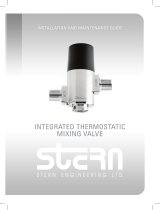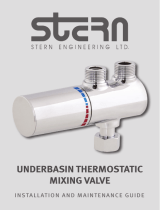Page is loading ...

Valves, controls + systems
“Brawa-Mix 97” Thermostatic Valve
Installation & Operation Instructions
Installation
• The valve can be installed in any orientation.
• Maximum differential pressure between hot & cold water
supply 5 bar.
• Control range 35-46 °C
• Minimum temperature differential between hot water inlet
and mixed outlet 10 °C to ensure performance.
• In order to protect the closely machined internal surfaces of
the “Brawa-Mix 97” and also the check valves within the fit-
tings kit, we would strongly recommend the use of Y type
line strainers (e.g. 1120006, 1121006).
• In the event of solder tailpipes being used, the flushing
body (Item No. 1309351) should be fitted during soldering,
to avoid heat damage to the “Brawa-Mix 97” valve.
• In order to avoid malfunction it is essential that no jointing
compounds are used to install the valve.
• Service isolating valves must be installed on hot and cold
supply pipes.
• We recommend that 20 to 30 alternating hold & cold shut
off operations be carried out before commissioning.
Flushing Prior To Operation
• It is essential that the pipework systems are thoroughly
flushed prior to the operation of the valve.
• Break unions and remove valve body.
• Install recommended flushing body (Item No. 1309351)
• Open cold water isolation valve to flush cold water line,
close when water flows cleanly.
• Open hot water isolation valve to flush hot water line,
close when water flows cleanly.
• Check and clean hot & cold water strainers.
• Remove flushing body.
• Reinstall valve body and tighten unions.
Commissioning Procedure
a Check that the designation of the “Brawa-Mix 97”
matches the intended application.
b Check that the supply pressures are within the range
of operating pressures for the designation of the valve.
c Check that the supply temperatures are within the range
permitted of the valve and by guidance information on the
prevention of legionella etc.
d Open hot and cold water isolation valves fully.
e Adjust the mixed water to the correct maximum
temperature as laid down in Table 1 by turning the
temperature adjustment handwheel
-
or +.
f Once the correct temperature is obtained, remove
adjustment handwheel by loosening the captive screw
and tighten the lock nut.
g Replace the adjustment handwheel and tighten the
captive screw.
h Record the temperature of the hot and cold supplies.
i Record the temperature of the mixed water at the largest
draw-off flow rate.
j Record the temperature of the mixed water at a smaller
draw-off flow-rate, which shall be measured.
k Isolate the cold water supply and monitor the mixed
water temperature. Record the maximum temperature
achieved as a result, and the final temperature.
NOTE: The final mixed water temperature should not
exceed the values in Table 2 below, and any higher
temperature should occur only briefly.
l Record the equipment, thermometer etc. used for the
measurements.
Table 2: Guide to the maximum continuous
temperatures during site tests.
WRc Certificate No. BC300/0507
To ensure correct operation, this Thermostatic Mixing
Valve shall be installed and maintained in accordance
with the following instructions.
Table 1: Conditions for Normal Use
Operating Pressure Range High Low
Max. static Pressure (bar) 10 10
Flow pressure, hot & cold (bar) 1 to 5 0.2 to 1
Hot supply temperature (°C) 52 to 65 52 to 65
Cold supply temperature (°C) 5 to 20 5 to 20
In-Service tests
• The purpose of in-service tests is to regularly monitor and
record the performance of the thermostatic mixing valve.
Deterioration in performance can indicate the need for
service work on the valve and/or the water supplies.
Application Mixed water temperature
-
°C
Bidet 40
Shower 43
Washbasin 43
Bath (44 °C fill) 46
Bath (46 °C fill) 48
The “Brawa-Mix 97” is certificated for use as a “Type 3”
valve on the following outlet designations only when
fitted with the appropriate sized tailpipe set.
(41, 44 or 46 max.) relates to the maximum set mixed water
temperature as defined within HGN “SAFE” Hot Water &
Surface Temperatures.
* Refer to the above HGN for guidance when using
designation HP-T46.
15 mm or 22 mm 22 mm only
HP-S (41 max.) HP-T44 (44 max.)
HP-W (41 max.) HP-T46 (46 max.)*
LP-W (41 max.) LP-SE (41 max.)

Service Test Procedure
Carry out the procedures h, i and j of the above commissio-
ning procedure, using the same measuring equipment, or
equipment to the same specifications.
• If the mixed water temperature has changed significantly
from the previous test results (e.g. > 1 k), record the chan-
ge and before re-adjusting the mixed water temperature
check:
1. that in-line or integral strainers are clean.
2. that any in-line or integral check valves or any other
anti-backsiphonage devices are in good working order.
3. that any isolating valves are fully open.
• With an acceptable mixed water temperature, complete
procedures k and l of the above commissioning proce-
dure.
• If at step k the final mixed water temperature is greater
than the values in Table 2 above, and/or the maximum
temperature exceeds the corresponding value from the
previous test results by more than 2 K, the need for servi-
cing work is indicated.
• In-service tests should be carried out with a frequency
which identifies a need for service work before an unsafe
temperature can result.
Frequency of In-Service Tests
• 6 to 8 weeks after commissioning carry out tests above.
• 12 to 15 weeks after commissioning carry out tests above.
• Depending on the results of the above tests, proceed as
follwows:
1. If no significant changes (e.g. 압1 K) in mixed water
temperatures are recorded between commissioning and
the first or second in-service tests, then the next in-ser-
vice test can be deferred to 24 or 28 weeks after com-
missioning.
•2. If small changes (e.g. 1 to 2 K) in mixed water tempera-
tures are recorded in only one of these periods, necessi-
tating adjustment of the mixed water temperature, then
the next in-service test can be deferred to 24 to 28
weeks after commissioning.
OVENTROP GmbH & Co. KG
Paul-Oventrop-Straße 1
D-59939 Olsberg
Telephone +49 (0) 29 62 82-0
Telefax +49 (0) 29 62 82-450
E-Mail mail@oventrop.de
Internet www.oventrop.com
For an overview of our global presence visit
www.oventrop.com.
Subject to technical modification without notice.
130035182 11/2019
•3. If small changes (e.g. 1 to 2 K) in mixed water tempera-
tures are recorded in both of these periods, necessita-
ting adjustment of the mixed water temperature, then
the next in-service test should be carried out at 18 to 21
weeks after commissioning.
•4. If significant changes (e.g. > 2 K) in mixed water tempe-
ratures are recorded in either of these periods, necessi-
tating service work, then the next in-service test should
be carried out at 18 to 21 weeks after commissioning.
• The general principle to be observed after the first 2 or 3
Inservice tests is that the intervals between future tests
should be set to those which previous tests have shown
can be achieved with no more than a small change in
mixed water temperature.
Recommended Spares
• It is recommended that replacement disc strainers and/or
strainer baskets are held for integral strainers and ”Y” type
strainers respectively.
Problem Solving
Problem
No or poor mixed water flow
Poor response on cold water failure
Mixed water temperature too hot or to
cool
Fluctuating mixed water temperature
a) Lack of water supply
b) Insufficient water pressure
c) Blocked strainers
d) Jointing compound used
a) Hot water inlet temperature too low
b) Insufficient hot/mixed water tempera-
ture differential
Incorrect temperaure setting
Lack of available hot or cold flow,
often due to poor balancing of cold
water system
a) & b) Check hot & cold water supplies
(incl. pressure)
c) Clean or replace strainers
d) If blocked, replace valve
a) Increase hot water inlet temperature
b) Increase differential to above mimi-
mum 10 K)
Adjust valve in accordance with
Installation & Operation Instruction
sheet
a) Check isolating valve are fully open
b) Check for flow stavation at the
“Brawa-Mix 97” when cold taps are
opened
Possible Cause Recommended Action
/

